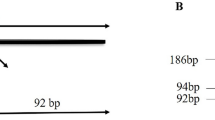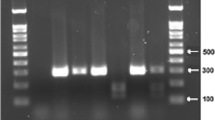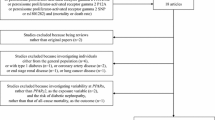Abstract
Tumor suppressor protein p53 has been demonstrated to regulate genes involved in energy generating metabolic pathways and apoptosis. To date, a new field of research is the involvement of TP53 codon 72 (Arg72Pro) polymorphism in the diabetic disease. The aim of this study was to evaluate whether the genotype and the related genetic models of Arg72Pro polymorphism of TP53 (rs1042522) are associated with insulin resistance and its metabolic parameters in diabetic and non-diabetic subjects. We examined 335 type 2 diabetic patients (65.5 ± 8.4 years) and 367 non-diabetic subjects (60.5 ± 11.7 years). The results were validated in a validation sample consisting of 199 type 2 diabetic (66.2 ± 8.5 years) and 224 non-diabetic subjects (61.2 ± 12.7 years). In the study sample, the analysis of covariance, adjusted for the effects of age, gender and BMI, showed a significant genotype–diabetes effect on insulin resistance evaluated by HOMA-IR (p = 0.038). This result was mediated by variations in fasting plasma insulin (p = 0.027), as no TP53 genotype–diabetes effects were detected for fasting plasma glucose. In particular, in the diabetic subjects, Pro/Pro genotype was associated with lower values of HOMA-IR with respect to Arg/Arg (p = 0.013) and Arg/Pro (p = 0.006) carriers. No difference in HOMA-IR between diabetic and non-diabetic Pro/Pro carriers was found. Significant recessive model–diabetes interaction effects on fasting insulin and HOMA-IR adjusted for age, sex and BMI were found (p = 0.007 and p = 0.029, respectively). Linear regression analyses, based on the assumption of an additive genetic model adjusted for age, sex and BMI, highlight p53 gene–diabetes interaction effects on fasting insulin (β = −1.27; p = 0.001) and HOMA-IR (β = −0.22; p = 0.006). The results of statistical analyses on fasting insulin and HOMA-IR were all confirmed in the validation sample. Furthermore, the logistic regression models confirmed that the effect of HOMA-IR levels on diabetes was moderated by Pro/Pro genotype in both study and validation samples (OR = 0.29, p = 0.034, 95 % CI = 0.09–0.91, OR = 0.37, p = 0.035, 95 % CI = 0.15–0.93, respectively). Our findings suggest that p53 codon 72 (Arg72Pro) polymorphism influences insulin resistance in type 2 diabetic patients independently of body mass.
Similar content being viewed by others
References
Green DR, Chipuk JE (2006) p53 and metabolism: inside the TIGAR. Cell 126:30–32
Bensaad K, Tsuruta A, Selak MA, Vidal MN, Nakano K et al (2006) TIGAR, a p53-inducible regulator of glycolysis and apoptosis. Cell 126:107–120
Matoba S, Kang JG, Patino WD, Wragg A, Boehm M et al (2006) p53 regulates mitochondrial respiration. Science 312:1650–1653
Crighton D, Wilkinson S, O’Prey J, Syed N, Smith P et al (2006) DRAM, a p53-induced modulator of autophagy, is critical for apoptosis. Cell 126:121–134
Vousden KH, Ryan KM (2009) p53 and metabolism. Nat Rev Cancer 9:691–700
Minamino T, Orimo M, Shimizu I, Kunieda T, Yokoyama M et al (2009) A crucial role for adipose tissue p53 in the regulation of insulin resistance. Nat Med 15:1082–1087
Thomas M, Kalita A, Labrecque S, Pim D, Ban L (1999) Two polymorphic variants of wild-type p53 differ biochemically and biologically. Mol Cell Biol 19:1092–1100
Bonafé M, Salvioli S, Barbi C, Trapassi C, Tocco F et al (2004) The different apoptotic potential of the p53 codon 72 alleles increases with age and modulates in vivo ischemia-induced cell death. Cell Death Differ 11:962–973
Bergamaschi D, Samuels Y, Sullivan A, Zvelebil M, Breyssens H et al (2006) iASPP preferentially binds p53 proline-rich region and modulates apoptotic function of codon 72-polymorphic p53. Nat Genet 38:1133–1141
Jeong BS, Hu W, Belyi V, Rabadan R, Levine AJ (2010) Differential levels of transcription of p53-regulated genes by the arginine/proline polymorphism: p53 with arginine at codon 72 favors apoptosis. FASEB J 24:1347–1353
Molina V, Papiol S, Sanz J, Rosa A, Arias B et al (2011) Convergent evidence of the contribution of TP53 genetic variation (Pro72Arg) to metabolic activity and white matter volume in the frontal lobe in schizophrenia patients. Neuroimage 56:45–51
Gomez-Sanchez JC, Delgado-Esteban M, Rodriguez-Hernandez I, Sobrino T, Perez de la Ossa N et al (2011) The human Tp53 Arg72Pro polymorphism explains different functional prognosis in stroke. J Exp Med 208:429–437
Gaulton KJ, Willer CJ, Li Y, Scott LJ, Conneely KN et al (2008) Comprehensive association study of type 2 diabetes and related quantitative traits with 222 candidate genes. Diabetes 57:3136–3144
Burgdorf KS, Grarup N, Justesen JM, Harder MN, Witte DR et al (2011) Studies of the association of Arg72Pro of tumor suppressor protein p53 with type 2 diabetes in a combined analysis of 55, 521 Europeans. PLoS One 6:e15813
American Diabetes Association (2011) Diagnosis and classification of diabetes mellitus. Diabetes Care 34(Suppl 1):S62–S69
Bonafè M, Olivieri F, Mari D, Baggio G, Mattace R et al (1999) p53 codon 72 polymorphism and longevity: additional data on centenarians from continental Italy and Sardinia. Am J Hum Genet 65:1782–1785
Matthews DR, Hosker JP, Rudenski AS, Naylor BA, Treacher DF et al (1985) Homeostasis model assessment: insulin resistance and beta-cell function from fasting plasma glucose and insulin concentrations in man. Diabetologia 28:412–419
Wallace TM, Levy JC, Matthews DR (2004) Use and abuse of HOMA modelling. Diabetes Care 27:1487–1495
Gallwitz B, Kazda C, Kraus P, Nicolay C, Schernthaner G, Acta Diabetol (2011) Contribution of insulin deficiency and insulin resistance to the development of type 2 diabetes: nature of early stage diabetes. Acta Diabetol. doi:10.1007/s00592-011-0319-4
Oda E (2012) Metabolic syndrome: its history, mechanisms, and limitations. Acta Diabetol 49:89–95
Kanat M, Norton L, Winnier D, Jenkinson C, DeFronzo RA et al (2011) Impaired early- but not late-phase insulin secretion in subjects with impaired fasting glucose. Acta Diabetol 48:209–217
Qu L, He B, Pan Y, Xu Y, Zhu C et al (2011) Association between polymorphisms in RAPGEF1, TP53, NRF1 and type 2 diabetes in Chinese Han population. Diabetes Res Clin Pract 91:171–176
Bojesen SE, Nordestgaard BG (2008) The common germline Arg72Pro polymorphism of p53 and increased longevity in humans. Cell Cycle 15:158–163
van Heemst D, Mooijaart SP, Beekman M, Schreuder J, de Craen AJ et al (2005) Variation in the human TP53 gene affects old age survival and cancer mortality. Exp Gerontol 40:11–15
Paolisso G, Barbieri M, Rizzo MR, Carella C, Rotondi M et al (2001) Low insulin resistance and preserved beta-cell function contribute to human longevity but are not associated with TH-INS genes. Exp Gerontol 37:149–156
Author information
Authors and Affiliations
Corresponding author
Additional information
Communicated by Massimo Federici.
Rights and permissions
About this article
Cite this article
Bonfigli, A.R., Sirolla, C., Testa, R. et al. The p53 codon 72 (Arg72Pro) polymorphism is associated with the degree of insulin resistance in type 2 diabetic subjects: a cross-sectional study. Acta Diabetol 50, 429–436 (2013). https://doi.org/10.1007/s00592-012-0450-x
Received:
Accepted:
Published:
Issue Date:
DOI: https://doi.org/10.1007/s00592-012-0450-x




